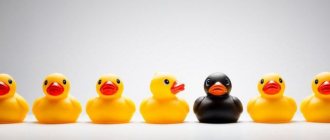I know how flies land on honey. I know death that prowls, destroying everything. I know books, truths and rumors. I know everything, but not myself. Francois Villon
Sometimes we can cross the line that seems impossible to cross. Sometimes we behave in such a way that we even judge ourselves for our wrongdoings. Why?
We cannot give explanations to many questions regarding our behavior. Do other people influence him, and how? What do we know about ourselves and our psychology? Are we independent in our narrowing? Who decided how to behave in society?
Behavior is the way a living being interacts with its environment that has developed during life.
Our behavior seems complex and inexplicable. It is believed that the essence of man is incomprehensible, and indeed this is so. No one knows how even a very close person might behave in a stressful or dangerous situation, since each of us has an instinct of self-preservation. And that's not the main thing. Human behavior depends on many factors.
Behavior as a moral category
Behavior is a set of human actions that an individual performs over a long period of time under given conditions. These are all actions, not individual ones. Regardless of whether actions are performed consciously or unintentionally, they are subject to moral evaluation. It is worth noting that behavior can reflect both the actions of one person and an entire team. In this case, both personal characteristics and the specifics of interpersonal relationships influence. Through his behavior, a person reflects his attitude towards society, towards specific people, and towards the objects around him.
The influence of emotions
Personal behavior is greatly influenced by emotions. Let's take a situation where one person from a small company sees a predator, he gets scared and screams, to which the whole company will react the same way, while someone might not even see that predator.
If such a situation had occurred in a crowd of people, the scale of the consequences would have been more serious, and panic would have begun. For this behavior, there is no need for explanation in words; everything happens at the automatic level.
What is interesting about animal communication is the phenomenon that unites them into one group and keeps them there. Animals don’t speak, so they don’t have words in their heads like people do, but emotional information is programmed by nature in the form of their peculiar behavior.
The emotional family dependence of certain species of animals, thanks to evolution, has been transformed into a kind of social system. This suggests that animals live in one family and are kept in it due to the amount of emotions suitable for all members of the family, since the animals have nothing else to offer.
The concept of rules of behavior, etiquette
Etiquette is a set of norms and rules that regulate a person’s relationships with others. This is an integral part of public culture (culture of behavior). It is expressed in a complex system of relationships between people. This includes concepts such as:
- polite, courteous and protective treatment of the fair sex;
- a sense of respect and deep respect for the older generation;
- correct forms of everyday communication with others;
- norms and rules of dialogue;
- being at the dinner table;
- dealing with guests;
- fulfillment of the requirements for a person’s clothing (dress code).
All these laws of decency embody general ideas about human dignity, simple requirements of convenience and ease in human relationships. In general, the rules of conduct coincide with the general requirements of politeness. However, there are also strictly established ethical standards that are immutable.
- Respectful treatment of students to teachers. Maintaining subordination in relation of subordinates to their management.
- Standards of behavior in public places, during seminars and conferences.
Decision Model
What is behavior in marketing? There is a model described by Lars Perner that illustrates the decision-making process regarding consumer behavior. It begins with problem recognition, when the consumer recognizes a need or desire that has not been met. This leads the consumer to search for information. If it is a low-involvement product, then the search will be internal, searching for alternatives solely from memory. If the product has a lot of participation, the search will be more thorough. For example, the consumer will read reviews or reports, or ask friends. The consumer then evaluates his alternatives by comparing prices, quality, making trade-offs between products, and narrowing down choices by eliminating less attractive products until only one option remains. Once this is determined, the consumer will purchase the product. Finally, it will evaluate the purchasing decision and the product purchased, citing factors such as value for money, appearance of the products, and purchasing experience. Deviant behavior is something that, in turn, goes beyond all the rules listed in the article.
Psychology as the science of behavior
Psychology is a science that studies the characteristics of human behavior and motivations. This area of knowledge studies how mental and behavioral processes proceed, specific personality traits, mechanisms that exist in a person’s mind and explain the deep subjective reasons for certain of his actions. She also considers the distinctive character traits of a person, taking into account the essential factors that determine them (stereotypes, habits, inclinations, feelings, needs), which can be partly innate and partly acquired, brought up in appropriate social conditions. Thus, the science of psychology helps us understand what behavior is, since it reveals its mental nature and the moral conditions of its formation.
Marketing
Consumer behavior refers to the processes in which consumers participate. And to the reactions they have to products or services. It is related to consumption and the feelings that consumers experience while purchasing and consuming goods and services. Consumers recognize needs or wants and go through a process to satisfy those needs. An individual's consumer behavior is the process they undergo as a customer, which includes the types of products purchased, the amount of money spent, the frequency of purchases. And what influences him when making a purchasing decision.
There are many factors that influence consumer behavior, and there are both internal and external factors. Internal factors include attitudes, needs, motives, preferences and perceptual processes, while external factors include marketing activities, social and economic factors and cultural aspects. Dr. Lars Perner from the University of Southern California argues that there are also physical factors that influence consumer behavior. For example, if a consumer is hungry, then this physical feeling of hunger will influence him to go out and buy a sandwich to satisfy his hunger.
Behavior as a reflection of a person’s actions
Depending on the nature of a person's actions, different types of behavior can be defined.
- A person may try to attract the attention of others through his actions. This behavior is called demonstrative.
- If a person undertakes any obligations and fulfills them in good faith, then his behavior is called responsible.
- Behavior that determines the actions of a person aimed at the benefit of others, and for which he does not require any reward, is called helping.
- There is also internal behavior, which is characterized by the fact that a person decides for himself what to believe in and what to value.
There are other, more complex types of behavior.
- Deviant behavior. It represents a negative deviation from norms and patterns of behavior. As a rule, it entails the application of various types of punishment to the offender.
- If a person demonstrates complete indifference to his surroundings, a reluctance to make decisions on his own, and mindlessly follows those around him in his actions, then his behavior is considered conformist.
Hierarchy of differences
What distinguishes people from animals is that they can gain recognition in a variety of ways. A person can achieve emotional support, that is, the respect of others, by demonstrating his talents. This develops self-esteem in an individual, since it is impossible without the recognition of the society that surrounds them.
It is on these principles that modern society lives. All that remains to be added is that a person who achieves emotional recognition from society begins to own the opinion of this society, and therefore becomes an authority who can subsequently influence the behavior of society as a whole.
People look for any opportunity to gain respect, and if they fail to gain recognition for their own abilities, then any means are used to achieve the goal.
Some try to gain respect in their religion or nationality, while others demonstrate the level of their cars and clothing brands or socially unacceptable behavior.
These things say nothing about the mental level of their owners, although they make an impression on many members of society. There are people who conquer mountains or throw themselves into abysses, bask on beaches or go on trips, just so that at least someone would appreciate their actions as achievements.
Code of Conduct
Close attention is paid to the norms of human behavior in society. A norm is a primitive form of a requirement regarding morality. On the one hand, this is a form of relationship, and on the other, a specific form of consciousness and thinking of the individual. A norm of behavior is constantly reproduced similar actions of many people, obligatory for each person individually. Society needs people to act in given situations according to a certain scenario, which is designed to maintain social balance. The binding force of norms of behavior for each individual person is based on examples from society, mentors and the immediate environment. In addition, habit plays an important role, as does collective or individual coercion. At the same time, norms of behavior must be based on general, abstract ideas about morality (the definition of good, evil, and so on). One of the tasks of properly educating a person in society is to ensure that the simplest norms of behavior become an internal need of a person, take the form of a habit and are carried out without external and internal coercion.
The role of culture
Finally, culture also greatly influences human behavior. Children absorb the beliefs of certain cultures from such a young age that they change greatly as they grow. These beliefs are taken into account in everyday life. Which leads to people from different cultures acting differently. These differences affect how different cultures and regions of the world interact and express themselves.
Raising the younger generation
One of the most important moments in raising the younger generation is conversations about behavior at school. The purpose of such conversations should be to expand the knowledge of schoolchildren about the culture of behavior, to explain to them the moral meaning of this concept, as well as to develop in them the skills of correct behavior in society. First of all, the teacher must explain to students what behavior is, that it is inextricably linked with the people around them, that how the teenager behaves determines how easy and pleasant it will be for these people to live next to him. Teachers should also cultivate positive character traits in children using the examples of books by various writers and poets. The following rules also need to be explained to students:
- how to behave at school;
- how to behave on the street;
- how to behave in a company;
- how to behave in city transport;
- how to behave when visiting.
It is important to pay special attention, especially in high school, to such an issue as a girl’s behavior in the company of classmates, as well as in the company of boys outside of school.
Crushes the owner or upholstered furniture with his paws
Cats mash their owners with their paws because:
- they feel completely safe, just like in childhood, when, as kittens, while feeding, they kneaded their mother’s breasts with their front paws to increase the flow of milk to her nipples;
- they experience true pleasure, and the only way to express gratitude and love to the owner is to sit on his lap and look into his eyes, touching his paws;
- they want to protect a loved one from invisible enemies, leaving odorous marks on him with the help of sweat glands located on the paw pads;
- do therapeutic massage.
These animals crush furniture with their paws to:
- prepare her for bed;
- relieve stress (rhythmic, monotonous movements help them quickly calm down);
- realize sexual instinct during the mating season;
- mark the object of trampling.
Public opinion as a reaction to human behavior
Public opinion is a mechanism through which society regulates the behavior of each individual. Any form of social discipline, including traditions and customs, falls under this category, because for society it is something like legal norms of behavior that the vast majority of people follow. Moreover, such traditions form public opinion, which acts as a powerful mechanism for regulating behavior and human relationships in various spheres of life. From an ethical point of view, the determining point in regulating an individual’s behavior is not his personal discretion, but public opinion, which is based on certain generally accepted moral principles and criteria. It must be recognized that an individual has the right to independently decide how to behave in a given situation, despite the fact that the formation of self-awareness is greatly influenced by the norms accepted in society, as well as collective opinion. Under the influence of approval or censure, a person’s character can change dramatically.
Destructive - what does it mean?
Let's define the meaning of the word destructive. The term is derived from the Latin word destructivus, which means “destructive.” What does destructive mean?
Destructive is:
- destructive process;
- something malfunctions;
- destruction, disintegration of structures, connections, dependencies.
The definition of a concept depends on the context, the phrase in which it is used. Let's consider popular cases of using the term, its definition in all phenomena.
Destructive relationships
Destructive relationships are toxic, dependent or codependent, dangerous relationships in which both or one participant suffers. Violence, restriction of freedom and development, conflicts, humiliation, tyranny, total control are a small part of what is present in these relationships. They destroy the personalities and lives of the participants.
Signs of a toxic relationship:
- ignoring the opinions, interests, desires, needs of the partner;
- neglect of a partner;
- chemical dependencies in one or both participants;
- feeling of uselessness, indifference;
- beatings, humiliation;
- betrayal;
- feeling of worthlessness, inferiority, low self-esteem;
- manipulation, including jealousy, tears, guilt;
- chronic nervous tension;
- chronic feeling of unhappiness, feeling of being a victim.
Love, according to Fromm’s definition, is an active interest in life and the development of the subject of love. This is what a healthy relationship looks like. This is a union of two independent people, independent financially, morally, physically. Everyone is free, but at the same time everyone wants to spend time with the other, because together they can achieve even more, they enrich each other.
Destructive criticism and communication
Destructive criticism is malicious, caustic, belittling remarks that do not contribute to personal development and demotivate. This is a criticism of personality, not of actions or individual traits. This is the imposition of your opinion, an attempt to “imprison” someone to suit you, to force them to do something the way you want. After toxic criticism, there is no desire to try again, to try something new. Disappointment in yourself, anger, a feeling that you have been doused with slop and trampled on, an attitude of “I’m worthless” appear.
Toxic criticism leads to conflicts, wars, and quarrels. Destructive communication is claims, insults, reproaches. Like incorrect criticism, it leads to conflicts.
Destructive conflict
Constructive conflict brings people closer together, improves mutual understanding, and increases productivity. Destructive conflict has no benefit. The participants do not try to understand each other or solve the problem.
Features of the conflict:
- leads away from solving the problem;
- lowers the self-esteem of participants, drives them into a state of stress;
- aimed at searching for differences and contradictions between participants, rather than searching for compromises and commonalities;
- spoils the psychological climate in the team;
- does not contribute to the development of participants and their relationships.
Such conflicts are dangerous. They harm production, relationships, and the well-being of the participants.
Signs of toxic conflict behavior:
- mistrust;
- orders;
- accusations;
- dismissive, condescending attitude;
- refusal to accept another point of view, conviction that one is right;
- imposing one's opinion, coercion;
- criticism of others combined with non-acceptance of criticism towards oneself.
A destructive conflict is an irrational confrontation between two personalities. Such individuals have a sharply negative attitude; they do not try to interact or seek a compromise. They suppress others and are ready to go over their heads in order to achieve personal goals. A destructive conflict can only be resolved by a third party (intermediary, mediator).
Destructive feelings and emotions
Destructive emotions and feelings are an unprocessed force that destroys an individual from the inside. Resentment, jealousy, anxiety, sadness, longing, love - any feeling and emotion can become destructive if it does not find a way out. But, of course, more often we are talking about negative experiences and dissatisfaction.
Destructive thoughts and conversations
Obsessive thoughts or useless conversations that interfere with personal development. For example, phobias, flashbacks, replaying old situations with an alternative ending, excessive fantasizing, negative reasoning, lamentations about how bad everything in life is. They need to be replaced with productive actions, solving problems in the present.
Destructive character
Destructive character is the presence of qualities that hinder self-realization, personal development, and its interaction with society. This category includes gloominess, unsociability, isolation, shyness, fear of communication, stubbornness, egocentrism, etc.
Destructive personality
What does a destructive personality mean? This is a person whose activity is aimed at destroying social norms, institutions, and laws. At the same time, activity is aimed at creating one’s own, alternative identity, different from those models that the person is trying to destroy. Such a person cannot live outside of society, because only in interaction with other people does he find ways of self-affirmation, self-actualization, and self-presentation.
Personal destruction can be spontaneous and permanent. The first depends on conditions and manifests itself in specific circumstances. The second is always noticeable, in everything. In both cases, a person has a destructive attitude toward self-affirmation through aggression and the destruction of social objects. The severity of personality destructiveness ranges from passive phrases like “I hate this world, I despise all its foundations and norms” to active asocial actions. Such a person denies generally accepted values and norms and limits life to the framework of his worldview. This leads to a narrowing of thinking and consciousness.
A destructive person is an aggressive type who runs away from freedom. With the help of destruction, he tries to overcome his inferiority, which he feels due to his inability to reveal the potential for self-realization. Through destructive actions (mentally, physically), he suppresses the potential of other people. Such a person cannot adequately evaluate his actions and is hostile to the world.
Destructive influence
“Don’t be friends with this company, they have a bad influence on you,” parents sometimes tell their children. The influence of a bad company is an example of destructive influence. In addition, they often talk about the negative influence of other cultures on the culture of Russia, the influence of social networks on the minds of young people. Destructive influence is an impact from groups, individuals, systems, cultures, etc. that destroys the values and foundations of an individual. Most often we are talking about informational influence, propaganda of destructive phenomena, for example, deviations, antisocial behavior, homosexuality, extremism, etc.
Destructive activity
These are destructive acts and actions, for example, violence, massacres, wars, terrorism, destruction of natural and cultural heritage. Similar acts are noticeable in all countries, which indicates a universal human tendency towards destructive activities. Moreover, it is developing and acquiring new risks in direct proportion to technical and information progress. With the help of the Internet, it is easier for a person to influence society, and it is easier for society to influence a person. Unemployment, unstable socio-economic and political atmosphere in the country are factors that increase the tendency to destructive activities.
Due to destructive attitudes, a person’s perception and ability to evaluate himself and situations are distorted, and emotional disturbances arise.
Human behavior assessment
When considering the question of what behavior is, we must not forget about such a concept as assessing the behavior of an individual. This assessment consists of society’s approval or condemnation of a specific act, as well as the behavior of the individual as a whole. People can express their positive or negative attitude towards the subject being evaluated in the form of praise or blame, agreement or criticism, manifestations of sympathy or hostility, that is, through various external actions and emotions. In contrast to requirements expressed in the form of norms, which prescribe in the form of general rules how a person should act in a given situation, assessment compares these requirements with those specific phenomena and events that already take place in reality, establishing their compliance or non-compliance existing norms of behavior.
Ecology
Behavioral ecology is the study of the evolutionary basis of animal behavior due to environmental pressures. Behavioral ecology arose from ethology after Niko Tinbergen outlined four questions that should be considered in the study of animal behavior, among which are proximate causes, ontogeny, survival, and phylogeny.
If an organism has a trait that provides a selective advantage (that is, has adaptive value) in its environment, then natural selection will favor it. Adaptive meaning refers to the expression of a trait that affects fertility, as measured by an individual's reproductive success. Adaptive traits are those that produce more copies of a person's genes in future generations. Maladaptive traits are those that cause you to produce less. For example, if a bird that can sing louder attracts more mates, and singing loudly is an adaptive trait for that species because a louder bird is more common than less loud birds, thereby passing the louder genes into future generations.
Golden rule of behavior
In addition to the fact that we all know the generally accepted rules of behavior, there is a golden rule. It originated in ancient times, when the first essential requirements for human morality were formed. Its essence is to treat others in the way you would like to see this attitude towards yourself. Similar ideas were found in such ancient works as the teachings of Confucius, the Bible, Homer's Iliad, and so on. It is worth noting that this is one of the few beliefs that has survived to this day almost unchanged and has not lost its relevance. The positive moral significance of the golden rule is determined by the fact that it practically orients the individual towards the development of an important element in the mechanism of moral behavior - the ability to put oneself in the place of others and emotionally experience their condition. In modern morality, the golden rule of behavior is an elementary universal prerequisite for relationships between people, expressing a continuity with the moral experience of the past.
Precautionary measures
Ignoring can be an excellent defense against aggressive behavior. What does inappropriate behavior on the part of management mean? The boss is exactly the same person as everyone else; and therefore the motives for his aggression may not differ much from the motives of an impolite passenger on a bus. And like any offender, it is important for him not only to “let off steam”, but also to make sure that he has brought you out of emotional balance. If he sees that it is impossible to get a reaction from you, then he may soon get tired of such a game. To distract yourself from the flow of aggression directed at you, distract yourself from the situation in his office or simply start looking at an object. Also, psychologists do not recommend looking into the eyes of an enraged leader - if you need to do this, it is better to direct your gaze to the bridge of your nose.
In addition, if the manager begins to be rude, it is best to concentrate on improving the quality of your work. After all, in this case, he will have no reason for complaints, and therefore for emotional attacks too. You shouldn’t look for reasons for your boss’s inappropriate behavior. Most likely, in this situation, little depends on you, and the manager behaves aggressively due to troubles or his own bad manners.
Description of the Scottish Straight cat
Scottish cats differ in a number of characteristic features that are unique to this breed. Sometimes animals are often confused with the British species, but during the comparison process the following differences can be identified:
- more rounded head;
- the body has an oblong and elongated shape, which gives the animal elegance;
- body proportions are slightly reduced;
- the average weight of a cat is 3 - 5 kg, boys weigh slightly more than females;
- pets are very flexible and remain hardy and playful at any age.
Harmful cat habits
Not all cat habits are liked by owners; some habits create difficulties for people keeping a pet in an apartment:
Scratching furniture
Sharpening their claws is a natural need, this is how animals remove excess length and clean off the stratum corneum. It is necessary to install a scratching post and teach the cat to use it, strictly preventing attempts to tear up furniture, wallpaper, carpets, and floor coverings.
Tags
Sexually mature cats leave fragrant business cards on the corners of walls, legs of tables, and cabinets. This is how they indicate their right to territory and declare to females that they are ready to mate.
The acrid smell of the secretion is difficult to evaporate, absorbing into the surface. To avoid an unpleasant spirit in the house, to save yourself from unnecessary suffering, and the animal from illness, attempts to break free, it is recommended to castrate the cat. Especially if the owners do not plan to engage in breeding.
Eating out
Cats walking outside on their own can eat offerings from compassionate passers-by and food waste. Stale food causes poisoning, infectious diseases, indigestion, and vomiting. Particularly dangerous are the linings of “cathunters” stuffed with crushed glass and the points of fishing hooks.
Be sure to read:
How to scare cats away so that they don’t shit, mark and damage furniture, what smell they can’t stand
Utility companies leave out poisonous food to kill rats, but cats can also fall prey to coumarin. It is necessary to feed your pet well before leaving, and it is better to prevent self-walking.
Talkativeness
Intrusive meowing can be irritating for some owners. In this way, the cat signals hunger, fear, anxiety, and pain. Increased talkativeness is unusual for cats; once you figure out the reason, the animal immediately stops talking.
Keeping cats is a fascinating process; intelligent animals adopt the atmosphere of the house and their owners. It's funny to watch them play, fuss with children or other pets, and develop their character as they grow older. Some cat habits have become an inexhaustible source of memes, jokes, and funny videos. Share in the comments which pet habits you like and which you don’t?
Why do cats hiss when they sense danger?
Many people have repeatedly witnessed “cat fights.” When a cat attacks an enemy, it presses itself to the floor, lowers its ears and emits a terrible hiss. This is explained by the fact that cats are able to imitate and imitate various sounds. Therefore, smart animals chose to imitate a creature that they are practically afraid of - a poisonous snake. The cunning cat's brain understands that hissing is intuitively associated with a snake. That is why, in order to scare the enemy, the cat hisses.











